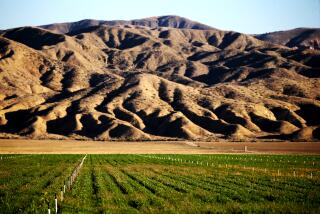In Yemen, race for profit is hastening a nightmare
- Share via
BEIT HUJAIRA, YEMEN — Across the countryside of this nation on the heel of the Arabian Peninsula, the pumps and drills roar. Wildcatters bore as much as 1,000 feet into the earth and draw out the valuable liquid. They pump it into tankers and haul it away to sell to the highest bidder.
But soon the reservoirs will run dry. As Yemen’s exploding population draws out more and more water from the parched land -- mostly to help feed a voracious appetite for khat, a mildly narcotic plant -- the bone-dry nation’s very existence is threatened.
The country faces its greatest water crisis, with underground levels dropping dramatically, scientists and government officials say.
“No one can tell you when the aquifer will dry up,” said Abdul Rahman Fadhl Iryani, the country’s minister of water resources. “But the trend is telling us the water will not be accessible.”
Experts blame the collapse of centuries-old water management strategies for the crisis, but khat plays a huge role. At least two-thirds of Yemen’s water consumption goes to growing the plant, a social lubricant used by as much as 90% of Yemeni men and a quarter of the women.
“Khat is consuming so much,” said Mohammed Abulahoum, a leading member of Yemen’s ruling political party. “This is the least discussed problem. But it’s the most important.”
Yemen’s experience offers a cautionary tale that shows the limits of free-market solutions to environmental problems. Instead of conserving water as it becomes scarcer and more precious, more and more Yemenis are rushing faster and faster to extract it from the earth and capture it from rains for profit, pushing the country toward an ecological nightmare.
--
Diminishing supply
“There’s a little bit of water out there, and the last drop of it will be the most valuable,” said Ramon Scoble, a longtime resident of Yemen and a water engineer for GTZ, a German development agency that operates in the country. “So there’s every incentive out there to go and get it.”
Farmers go to extraordinary lengths to grow khat, a nearly tasteless leafy plant that can fetch $2 to $50 a bag, depending on quality. It’s particularly finicky, growing only at high altitudes, vulnerable to frost and in need of large amounts of water. It begins to lose its psychotropic qualities within hours, which makes it easy for farmers to sell without going through middlemen.
At noon, Yemeni men begin pouring into khat markets, haggling with vendors for their daily bagfuls. They stuff the plant into their cheeks and chew on it for hours. It is said to produce a mildly euphoric feeling, and though it appears to have few addictive properties, some critics say it keeps people passive.
“Khat is no good,” said Mohammed Shorabi, an 18-year-old student who refuses to chew the leaf. “It is the whiskey of Yemen.”
Attempts at changing laws to correct the system have proved fruitless. Politicians who have tried to outlaw or at least restrict khat consumption have been pushed out of office by farmers and users.
“Most tribal areas get rich from khat,” said Abdullah Faqih, a Sana University professor of political science. “They’re very strong. If they don’t like the government, they can overthrow it.”
The country’s first water minister was removed a couple of years ago from his post for trying to outlaw wildcatters drilling for water wherever they pleased.
Decades of high-level corruption and waste have eroded any sense of communal purpose, said the head of one relief organization, who spoke on condition of anonymity.
“You have a kind of lawlessness among the elite,” he said. “At the top you tend to have powerful people who do what they want. The average farmer sees that example.”
Long ago, Yemenis carved out and maintained terraces along mountainsides to capture rainfall, and dug canals to draw water from flash floods. Tribal wars over water and land issues led to elaborate codes of conduct and consumption.
“Everything was measured and everything was cautious,” said Faisal Amin abu Ras, a Yemeni diplomat and tribal leader. “There was an etiquette.”
But those ancient water management strategies have collapsed. Yemen’s population jumped from 6 million in 1968 to 11 million in 1988. It’s 23 million now and is growing 4.5% a year, the sixth highest rate in the world. Demographers expect the population to reach 43 million by 2035.
The government subsidizes the exploitation of water for khat and other agriculture by selling diesel fuel for the artificially low price of about 65 cents a gallon, for an annual cost of $3.5 billion, or 14% of the country’s gross domestic product, in effect hastening the depletion of its own aquifers.
“Now anyone who has the means can access any amount of water,” said Iryani, the current water resources minister. “The technology came to a society with no legal framework.”
The result has been devastating. In and around Sana, the capital, farmers in the 1960s used to dig water wells with shovels. Now diesel-powered drills must burrow more than 1,000 feet into the earth before they hit water that is not potable without being treated.
“The deeper we drill, the more iron and fluoride, making the water less fit for consumption,” Iryani said.
--
Soaring demand
Water experts became alarmed as the depth began dropping by 6 to 10 feet a year. The annual rains that replenish the aquifers aren’t keeping up with demand.
The government in mid-July announced an ambitious plan to begin harvesting more rainwater, especially around Sana, but that would only deplete the aquifers.
“Wherever you are, water is in a bucket,” said Scoble, the water engineer. “You can’t change the bucket. At one point you’ve tipped over from credit into debit.”
In the countryside, villages hold rainwater in concrete pools replenished during two seasonal rainy periods. The burden of retrieving water often falls on girls, who spend hours each day navigating mountain roads and trails to get to the nearest clean water supply, usually in such a cistern fenced off to prevent animals from entering.
Busy with this chore, girls often can’t go to school. Yemen’s rural women have an illiteracy rate of 62%, a factor that contributes greatly to large families and overpopulation.
In remote villages, some cisterns are befouled by animals and bathers. Residents sometimes “stop distinguishing between clean and dirty water,” said Scoble of GTZ, a New Zealander who has become one of world’s leading experts on Yemen’s water troubles.
Near the village of Beit Hujaira, north of Sana, Jamila Abdullah draws from a cistern filled with brackish, months-old water. She knows the water is bad, she says. But she drinks it anyway. She has no choice: The nearest clean water supply for her mountaintop village is four miles away. The rains haven’t come for months, and the wells have dried up.
“It’s not good for me,” she says from behind a niqab covering all but her yellowed eyes. “There was a time it used to make me sick. But I’m used to it.”
The khat farms nearby glisten green.
--
More to Read
Sign up for Essential California
The most important California stories and recommendations in your inbox every morning.
You may occasionally receive promotional content from the Los Angeles Times.













